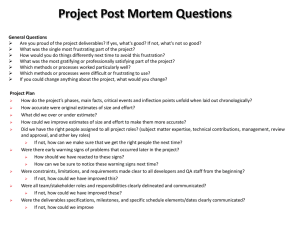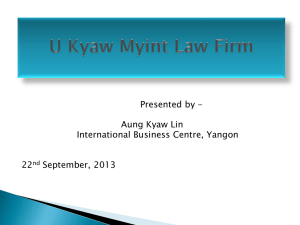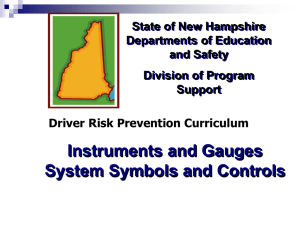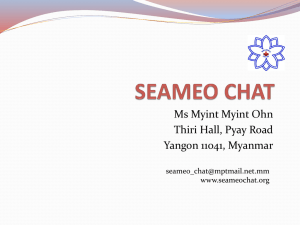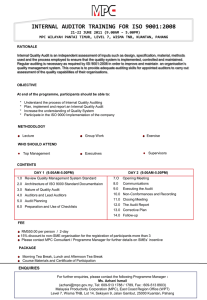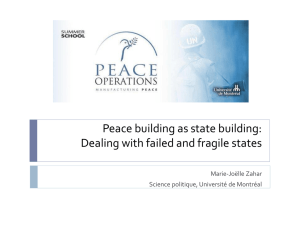Conflict Early Warning System (CEWS)
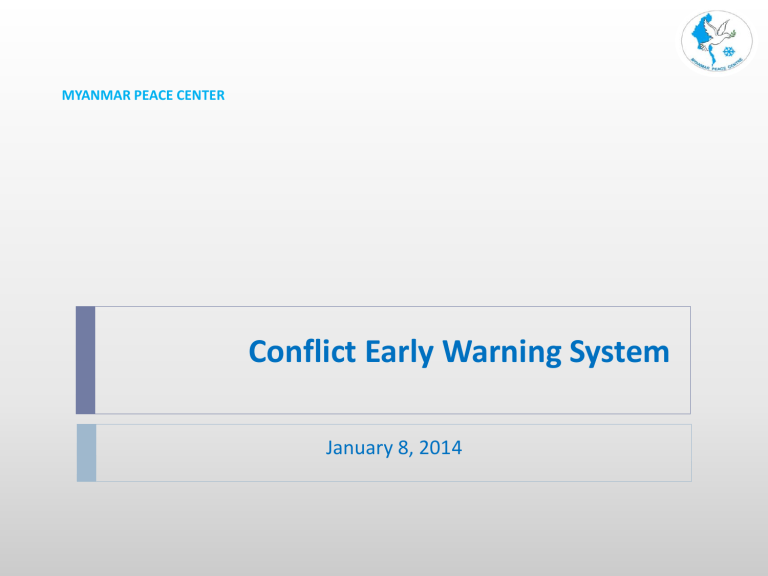
MYANMAR PEACE CENTER
Conflict Early Warning System
January 8, 2014
Contents
MPC Structure
CFNI Structure
Conflict Early Warning System – concept overview
Information management requirements
Challenges
Questions
The Myanmar Peace Center (MPC)
Established to assist the Union Peace-making Central
Committee and the Union Peace-making Work Committee for the peace process.
Serving as the focal point for international partners and civil society organizations on issues related to the peace process.
Facilitating dialogues between government and non-state actors.
Union Peace-making Central Committee
Union Peace-making Working Committee
Special Advisors
Program Director(s) / Assoc. Program
Director(s)
MPC committee
Executive Director
Donor Support Group
(Govts, IOs, NGOs, Projects, Experts)
Independent International Experts
Asst. Executive Director
Ceasefire
Negotiation
Program (CFN)
Negotiations
Implementation
Regulation
Monitoring
Training
Peace Dialogue
Program (PD)
Meetings
Negotiations
Dialogues
Process Control
Research
Training
Peace Building
Operations
Coordination
Program (PBOC)
Government
Relations
IO & NGO Relations
Private Sector
Relations
Operations
Outreach and
Public Diplomacy
Program (OPD)
Advocacy,
Communications and Social
Mobilization
Networking
News Room
Media Production
Social Media
Myanmar Mine
Action Centre
(MMAC)
Mine Risk
Education,
Demining,
Victim Assistance,
Advocacy and
Stockpile
Destruction
Seconded International Experts
Administration and
Support Division
(ASD)
Administration
Finance
Logistics
Support Services
Security
Legal
Ceasefire Negotiation and
Implementation (CFNI)
Monitoring
CFNI
(Program Director)
Program Manager
Capacity
Building
Early
Warning
Consultants
Coordination and Liaison
Conflict Early Warning System (CEWS)
Early warning is a process that:
(a) systematically monitors and reports conflict indicators;
(b) promotes an understanding among decision-makers of the nature and impacts of violent conflict; and
(c) alerts stakeholders of the potential outbreak, escalation, and resurgence of violent conflict
Conflict Early Warning System (CEWS)
CEWS Objectives:
Increase government, NGO, EAG and CSO awareness of the occurrence and/or likely occurrence of conflict
Increase the number and effectiveness of preventative peacebuilding initiatives in conflict-affected communities
Reduce local tensions through directly supporting community peacebuilding initiatives
Enhance awareness of the drivers of conflict – particularly amongst government and donor agencies
Conflict Early Warning System (CEWS)
CEWS Objectives:
Increase accountability amongst the protagonists of conflict through public diplomacy and awareness
Reduce the spread of rumours and accusations between groups that can be detrimental to the peace process
Improve the exchange of information between government and ethnic armed groups, in conjunction with joint monitoring mechanisms
CEWS Outputs
Daily update – a short qualitative snapshot of any key events from the previous 24 hours.
Ad hoc situation reports – updates published as required in the event of significant challenges to the security environment
Weekly update – quantitative and qualitative update of reporting across the previous week. Geographic focus on identified ‘hotspots’ with an update of each area’s ‘stability index’.
Monthly overview – in-depth analytical review focussing on the drivers of conflict, including recommended action for preventative policy solutions.
Geospatial mapping – conflict data, stability index and key indicators will be updated nearreal time via online mapping software. Data to be linked to key nodes via VPN connection.
Conflict drivers workshops – monthly briefing session based on in-depth analysis with key implementation partners.
Flexible peacebuilding fund – support to NGOs and local CSOs working on preventative/peacebuilding measures. - to be informed by EWS analysis, in consultation with donor partners.
External research and assessment – in addition to the routine analysis within the EWS, the
MPC will commission specialised research and assessment on issues identified as particular inhibitors to stability. The tailored field-based research will be used to inform policy advocacy strategies, and also to shape priorities for the MPC’s flexible peace fund.
MYANMAR PEACE CENTER
Early warning in context
Information management
Access database – automated algorithms – web-based reporting/GIS
Multiple sources of information
Verification required/duplication must be minimised
Data ownership/security
Long-term media monitoring automation
Information management
Challenges
Database/software development
Resource intensive nature of manual data input
Event verification
Accuracy/reliability of source data – particularly to the township level
Linking information to response mechanism


